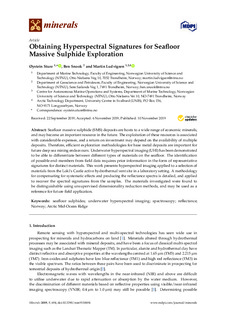| dc.contributor.author | Sture, Øystein | |
| dc.contributor.author | Snook, Ben | |
| dc.contributor.author | Ludvigsen, Martin | |
| dc.date.accessioned | 2019-11-13T13:29:33Z | |
| dc.date.available | 2019-11-13T13:29:33Z | |
| dc.date.created | 2019-11-11T09:16:38Z | |
| dc.date.issued | 2019 | |
| dc.identifier.citation | Minerals. 2019, 9 (11), . | nb_NO |
| dc.identifier.issn | 2075-163X | |
| dc.identifier.uri | http://hdl.handle.net/11250/2628303 | |
| dc.description.abstract | Seafloor massive sulphide (SMS) deposits are hosts to a wide range of economic minerals, and may become an important resource in the future. The exploitation of these resources is associated with considerable expenses, and a return on investment may depend on the availability of multiple deposits. Therefore, efficient exploration methodologies for base metal deposits are important for future deep sea mining endeavours. Underwater hyperspectral imaging (UHI) has been demonstrated to be able to differentiate between different types of materials on the seafloor. The identification of possible end-members from field data requires prior information in the form of representative signatures for distinct materials. This work presents hyperspectral imaging applied to a selection of materials from the Loki’s Castle active hydrothermal vent site in a laboratory setting. A methodology for compensating for systematic effects and producing the reflectance spectra is detailed, and applied to recover the spectral signatures from the samples. The materials investigated were found to be distinguishable using unsupervised dimensionality reduction methods, and may be used as a reference for future field application. | nb_NO |
| dc.description.abstract | Obtaining Hyperspectral Signatures for Seafloor Massive Sulphide Exploration | nb_NO |
| dc.language.iso | eng | nb_NO |
| dc.publisher | MDPI | nb_NO |
| dc.relation.uri | https://www.mdpi.com/2075-163X/9/11/694 | |
| dc.rights | Navngivelse 4.0 Internasjonal | * |
| dc.rights.uri | http://creativecommons.org/licenses/by/4.0/deed.no | * |
| dc.title | Obtaining Hyperspectral Signatures for Seafloor Massive Sulphide Exploration | nb_NO |
| dc.type | Journal article | nb_NO |
| dc.type | Peer reviewed | nb_NO |
| dc.description.version | publishedVersion | nb_NO |
| dc.source.pagenumber | 23 | nb_NO |
| dc.source.volume | 9 | nb_NO |
| dc.source.journal | Minerals | nb_NO |
| dc.source.issue | 11 | nb_NO |
| dc.identifier.doi | https://doi.org/10.3390/min9110694 | |
| dc.identifier.cristin | 1745812 | |
| dc.relation.project | Norges forskningsråd: 247626 | nb_NO |
| dc.description.localcode | c 2019 by the authors. Licensee MDPI, Basel, Switzerland. This article is an open access article distributed under the terms and conditions of the Creative Commons Attribution (CC BY) license (http://creativecommons.org/licenses/by/4.0/). | nb_NO |
| cristin.unitcode | 194,64,20,0 | |
| cristin.unitcode | 194,64,90,0 | |
| cristin.unitname | Institutt for marin teknikk | |
| cristin.unitname | Institutt for geovitenskap og petroleum | |
| cristin.ispublished | true | |
| cristin.fulltext | original | |
| cristin.qualitycode | 1 | |

